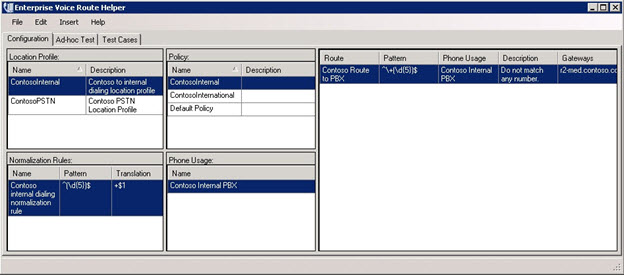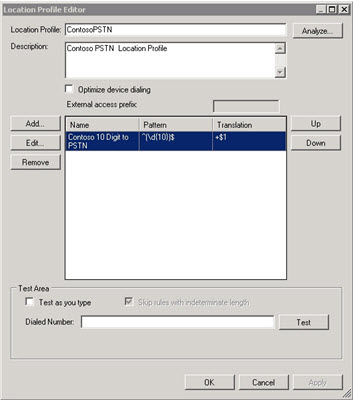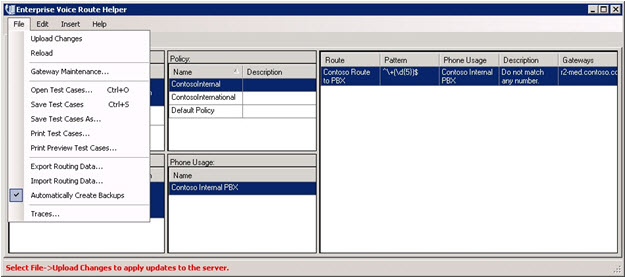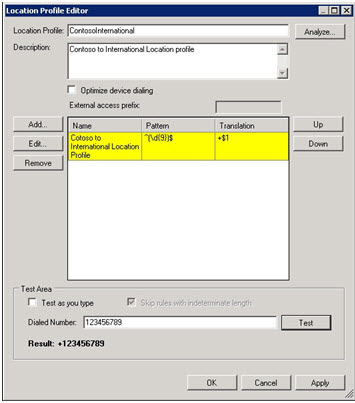Office Communications Server 2007 R2 Resource Kit Tool: Enterprise Voice Route Helper
The Office Communications Server 2007 R2 Resource Kit Enterprise Voice Route Helper tool can be used to troubleshoot and manage Microsoft Office Communications Server 2007 R2 enterprise voice policies. Enterprise Voice Route Helper is a versatile tool that can be used to design, implement, back up, and restore the global enterprise voice policies for an Office Communications Server 2007 R2 Voice over Internet Protocol (VoIP) implementation. You can download this and other Office Communications Server 2007 R2 Resource Kit tools from the Download Center.
Author: Mike Adkins
Publication date: April 2011
Product version: Microsoft Office Communications Server 2007 R2
Introduction
Enterprise Voice Route Helper, a tool in the Office Communications Server 2007 R2 Resource Kit, helps take the guesswork out of designing, implementing, and maintaining Office Communications Server 2007 R2 voice policies. Enterprise Voice Route Helper is easy to use-start RouteHelper.exe from the C:\Program Files\Microsoft Office Communications Server 2007 R2> command prompt. Begin any of the enterprise-level VoIP testing and implementation tasks that the tool was designed to perform.
Enterprise Voice Route Helper provides Communications Server VoIP administrators with a straightforward GUI. It allows them to administer any of the Communications Server VoIP policies. You can download this and other Office Communications Server 2007 R2 Resource Kit tools from the Download Center.
Description
Enterprise Voice Route Helper makes it possible to create or obtain a graphical representation of a working enterprise voice policy. This provides VoIP administrators with the versatility to do the following:
Create and test an enterprise voice policy that can be uploaded for immediate use in the Communications Server VoIP environment.
Make back-up copies of functional enterprise voice policies that can be used to perform point-in-time restore operations.
Download a copy of the working enterprise voice policies to perform troubleshooting steps that include the following:
- Testing existing or new enterprise voice policies.
- Editing existing or creating new enterprise voice policies.
- Editing existing or creating new location profiles.
- Editing existing or creating new phone number normalization rules and VoIP routes.
Upload the enterprise voice policies back into the live Communications Server VoIP environment when updates and testing have been completed.
Output
Enterprise Voice Route Helper, when launched in a live Communications Server VoIP environment, will access the current global VoIP policy information and display it in the GUI as shown in Figure 1.
Figure 1. Enterprise Voice Route Helper

Enterprise Voice Route Helper can be used to edit existing VoIP policies as shown in Figure 2.
Figure 2. Editing the location profile

Purpose
Enterprise Voice Route Helper provides a versatile GUI that can be used to do the following:
Download the active Communications Server VoIP policies.
Upload changes that have been made to the Communications Server VoIP policies by using the Administrative Tools console.
Export a working copy of the Communications Server VoIP policies.
Import a back-up copy of or an updated copy of the Communications Server VoIP policies.
Upload all new changes to the global VoIP policy as merged or as overwriting the existing enterprise VoIP policy.
Test all location profile normalization and routing rules for the Communications Server VoIP policies.
Requirements
Windows Server 2008 operating system
Windows Server 2003 Standard Edition operating system with Service Pack 2 (SP2)
Windows Server 2003 Enterprise Edition operating system with Service Pack 2 (SP2)
Permissions that are equivalent to a member of the RTCUniversalServerAdmins group or the Domain Admins group in the Active Directory Domain Services domain that hosts the Communications Server infrastructure
Examples
This section describes the various ways that Enterprise Voice Route Helper can be used to address configuration and troubleshooting issues that can coexist in the Communications Server VoIP policies.
The following example shows the File menu of Enterprise Voice Route Helper to upload changes and import or export the VoIP policies information as shown in Figure 3.
Figure 3. Enterprise Voice Route Helper File menu

The Location Profile editor makes it easy to add information to the pre-existing global VoIP policies as shown in Figure 4.
Figure 4. Adding a new location profile to the pre-existing global VoIP policies

The Test Cases tabbed page shows how Enterprise Voice Route Helper can be used to test the Communications Server location profiles and routing policies as shown in Figure 5. These tests provide Communications Server with a way to help ensure that the enterprise's VoIP policies perform as expected prior to their implementation.
Figure 5. Using Enterprise Voice Route Helper to test location profiles and routing policies

Summary
Enterprise Voice Route Helper provides Communications Server VoIP administrators with a versatile interface that allows them to design, edit, and implement a set of working VoIP polices for the Communications Server enterprise. If any pre-existing VoIP policies are present, Enterprise Voice Route Helper adds that information to its GUI for viewing, editing, or exporting while it is opening. Enterprise Voice Route Helper can be used to export the current Communications Server VoIP policies to a *.rtda file format for back-up and restore purposes. After using Enterprise Voice Route Helper to create a new set of VoIP policies, this tool can be used to test VoIP policies to help ensure that they function as expected.
Additional Information
To learn more, check out the following articles:
Lync Server Resources
- Lync Server 2010 documentation in the TechNet Library
- NextHop blog
- Lync Server and Communications Server resources
We Want to Hear from You
Keywords: enterprise, voice, route, helper, mediation, server, location, profile